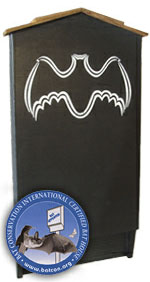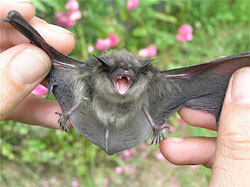|
Bat Houses...
Jason Hooper, Quilchena Golf Club, Richmond, British Columbia:
  "It's no doubt that our golf course provides the highly populated and developed city of Richmond with some much needed green-space, but did you know it also provides an ideal habitat for wildlife? Along with our resident swan, coyotes and bird species, this year alone we have spotted great horned owls, sandhill cranes, great blue herons, snakes (non-poisonous) and even a beaver! Many of these critters only visit us for a day or two, but at least they find what our course provides inviting enough for them to stop in.
In a continuing effort to 'go green', we will be installing two bat houses at the far west end of the property along the dyke. We hope the bats will recognize our generosity of providing them with a nice and cozy place to live, and in return will help us to reduce the summer mosquito population. Each one of these bat houses can house up to 300 bats and each bat can consume up to 1,200 mosquitoes in just 1 hour! The quick math on that results in the bats from our two houses consuming up to 720,000 mosquitoes an hour and 17,280,000 mosquitoes in a day! Obviously they don't feed for 24 straight hours, but the numbers are still impressive.
Each one of these bat houses can house up to 300 bats and each bat can consume up to 1,200 mosquitoes in just 1 hour... |
According to Canadian Bat Houses: 'Bats are nature's most effective defense against a variety of airborne pests as well as mosquitoes carrying the West Nile Virus. A bat house is an environmentally friendly method to promote mosquito and other pest control. A well-designed bat house will attract bats to the area, and is complimentary to an new or existing pest control program. The purpose of a bat house is to provide bats with shelter that makes an excellent place for 'roosting'. Bat houses are usually occupied in the summer months when bats are not hibernating.'
We are starting with two of these houses, but plan on adding more in the very near future. The houses are 41" tall and 18.5" wide, so they will not go unnoticed.
 You are probably asking yourself, "Is the bat symbol really necessary?" Yes, it is. The bat symbol actually plays a role by deterring wood peckers and other birds from damaging the hollow house. These bat houses are also the only Bat Conservation International certified houses made in Canada.
Erin Rutherford and Doug Sinclair from The South Coast Bat Action Team visited us this past Monday to help us choose locations on the course best suited for the houses. One will be installed on the first tree north of the opening we created at #4 green and the other will be located in the former "eagle tree" in the naturalized area at #5 tees and behind #4 green. Erin and Doug have also generously offered to help us monitor them for the first year as the houses become inhabited."
Visit Jason's blog at qgolfclub.blogspot.com.
|